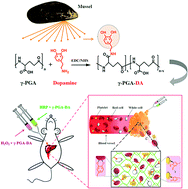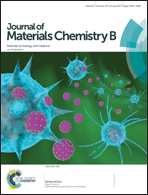A mussel-inspired poly(γ-glutamic acid) tissue adhesive with high wet strength for wound closure
Abstract
Injectable hydrogels are promising candidates for adhesives because of their ease of administration, minimal invasion, and biocompatibility. While developing surgical adhesives with strong wet tissue adhesion, controlled degradability and mechanical properties, and excellent biocompatibility have still been a significant challenge. Herein, inspired from nature, we report a novel mussel-inspired tissue-adhesive hydrogel composed of poly(γ-glutamic acid) and dopamine (γ-PGA–DA) that can bond tissues well and stop bleeding in a wet environment by improving its tissue adhesiveness via a horseradish peroxidase-mediated reaction. The hydrogel exhibited 10–12 fold stronger wet tissue adhesion strength (58.2 kPa) over the clinically used fibrin glue and more effective hemostatic ability following liver impalement in animal models (41.2% reduction in the average amount of bleeding compared with fibrin glue). In addition, the hydrogels demonstrated controlled gelation time, swelling ratio, microscopic morphology, biodegradability and tissue-like elastomeric mechanical properties, and exhibited excellent cyto/tissue-compatibility. The overall results suggest that the γ-PGA–DA hydrogels can be considerably applied as promising wet-resistant adhesives and hemostatic materials.



 Please wait while we load your content...
Please wait while we load your content...